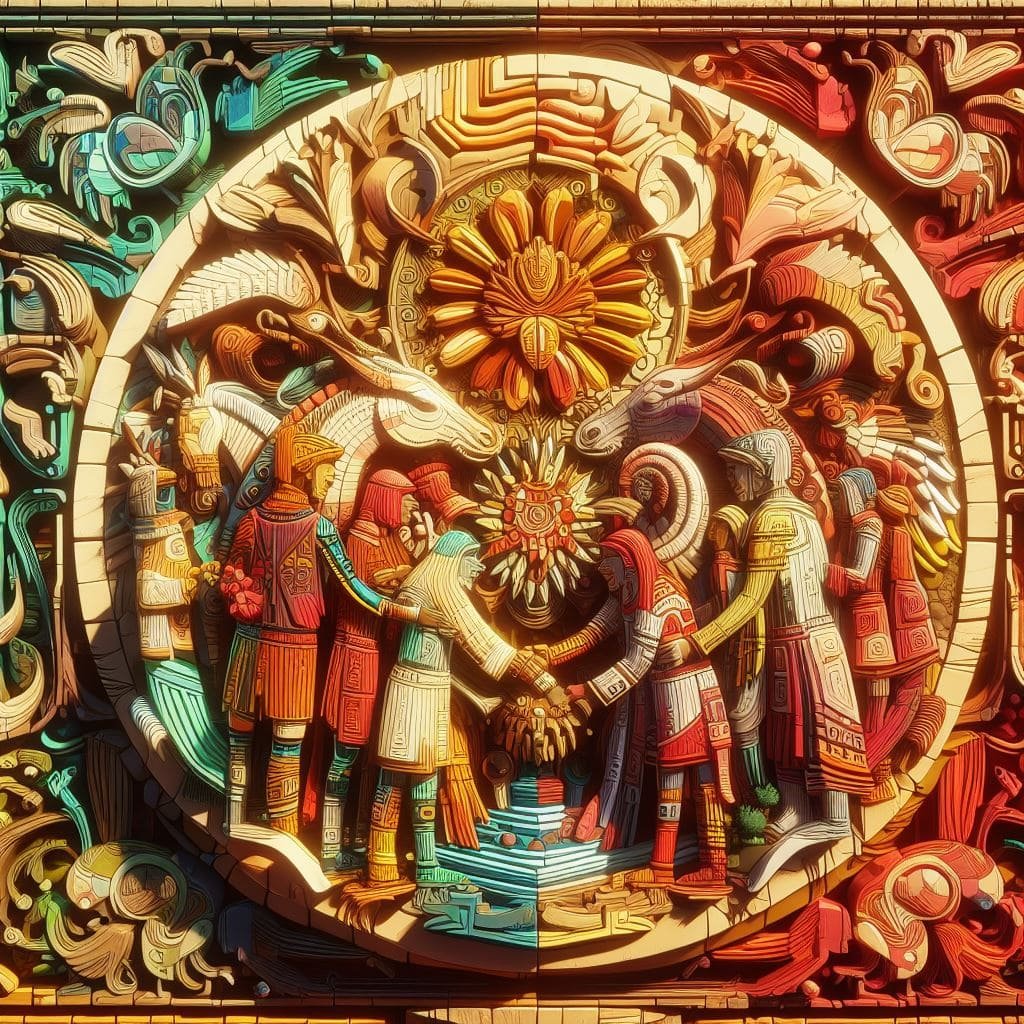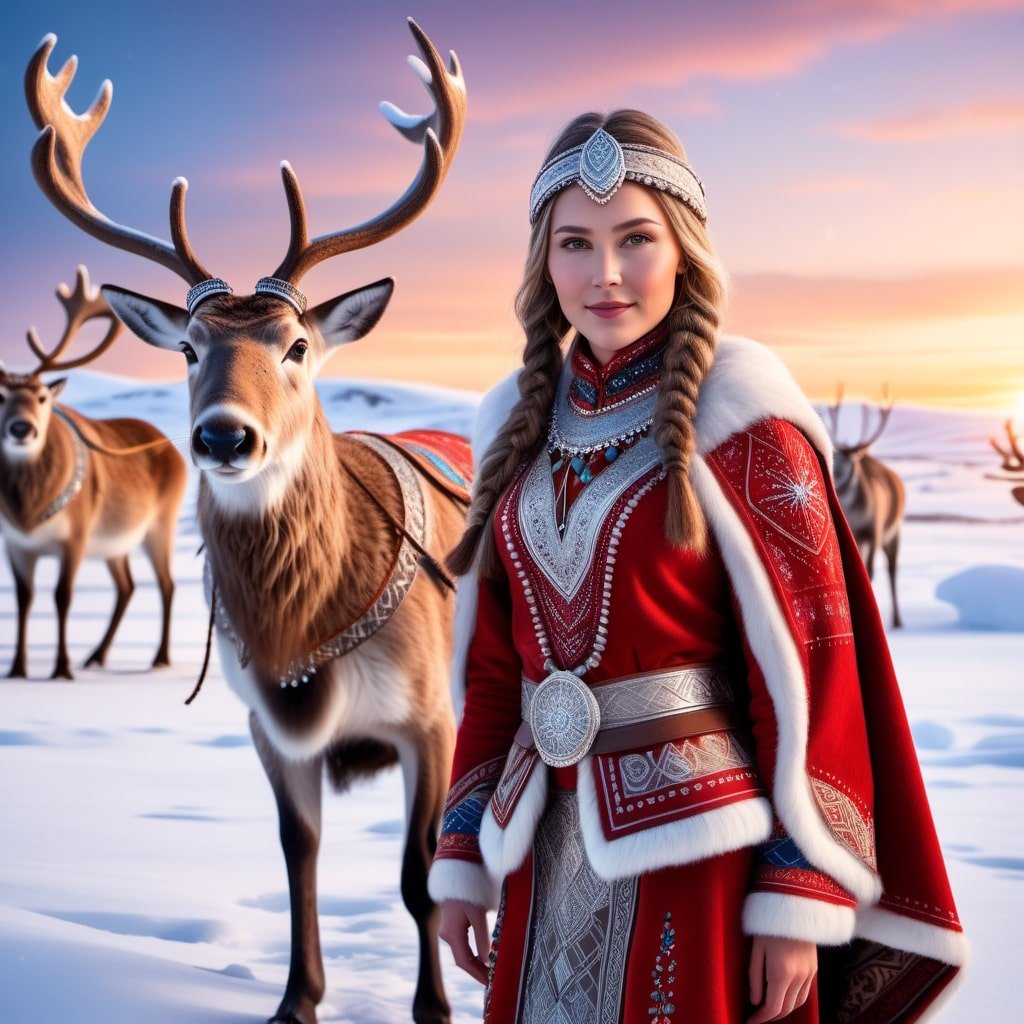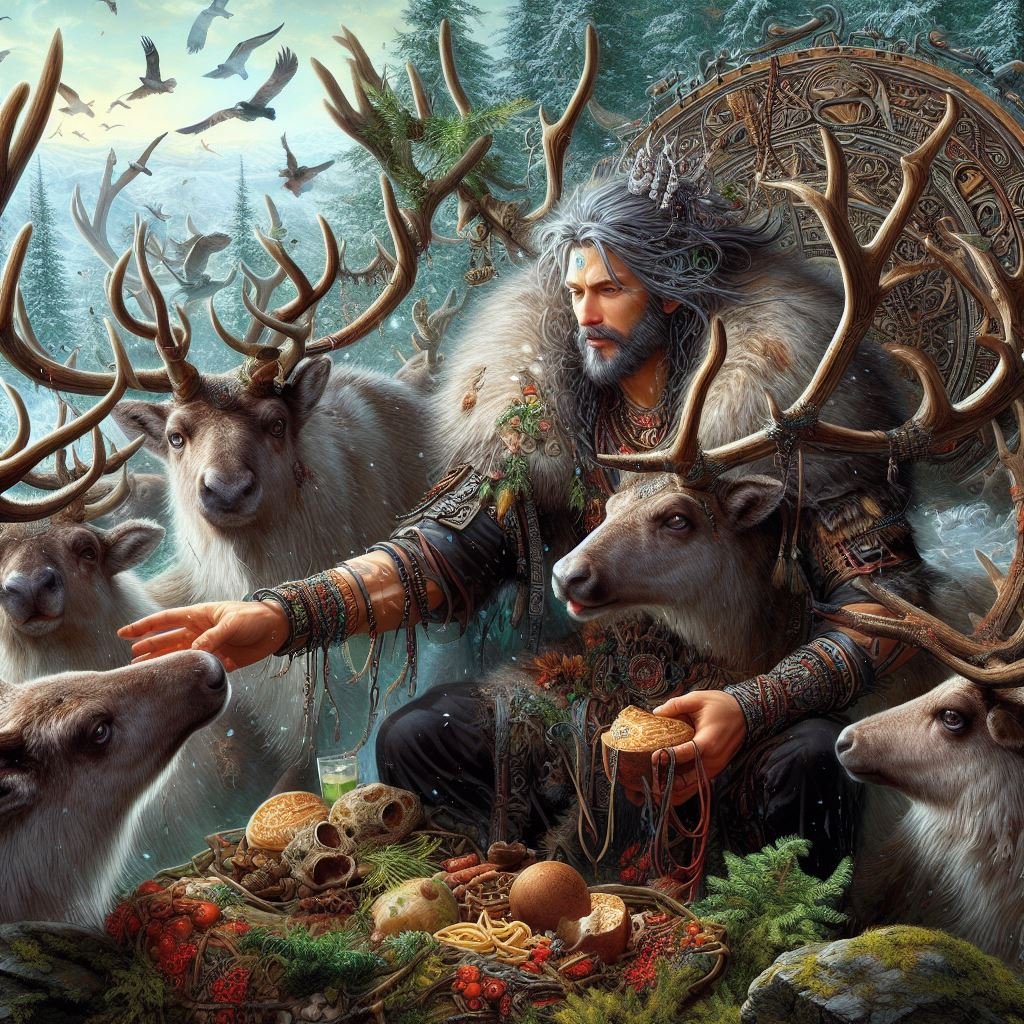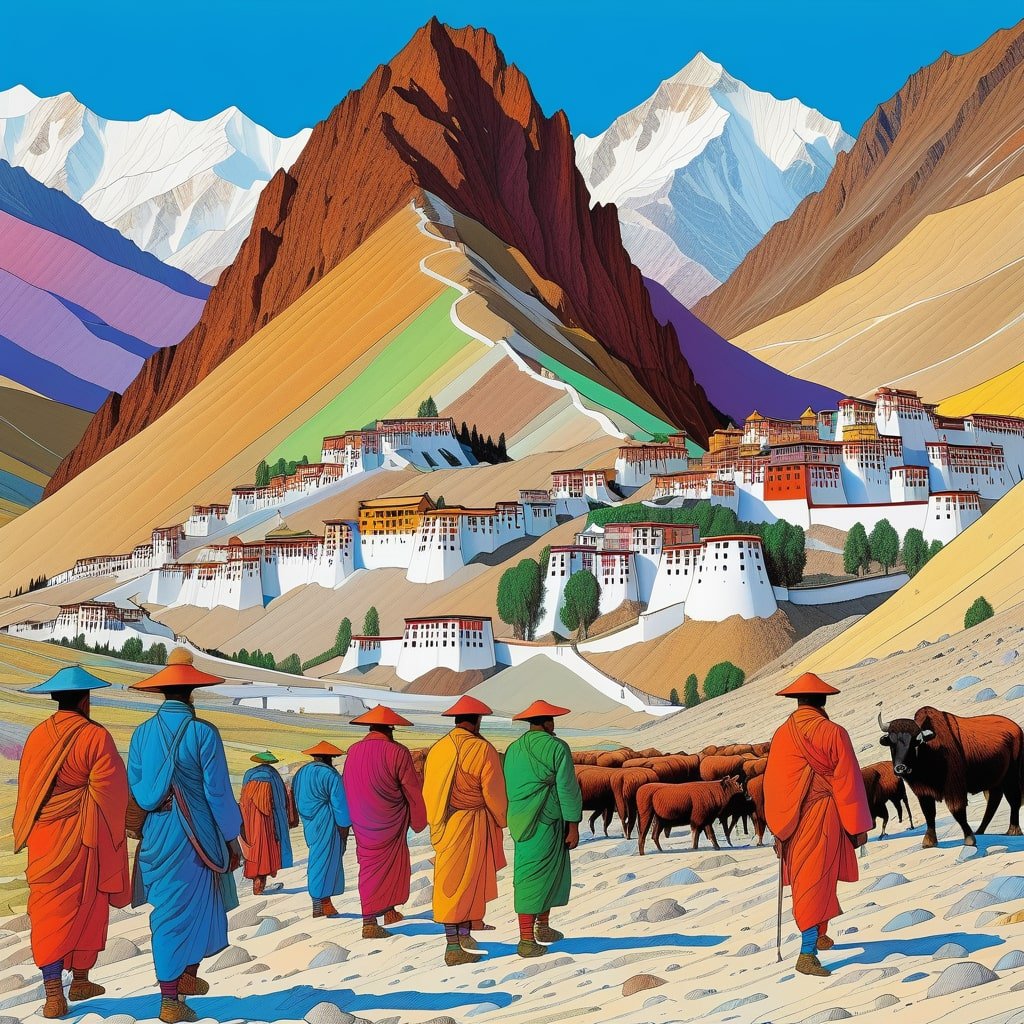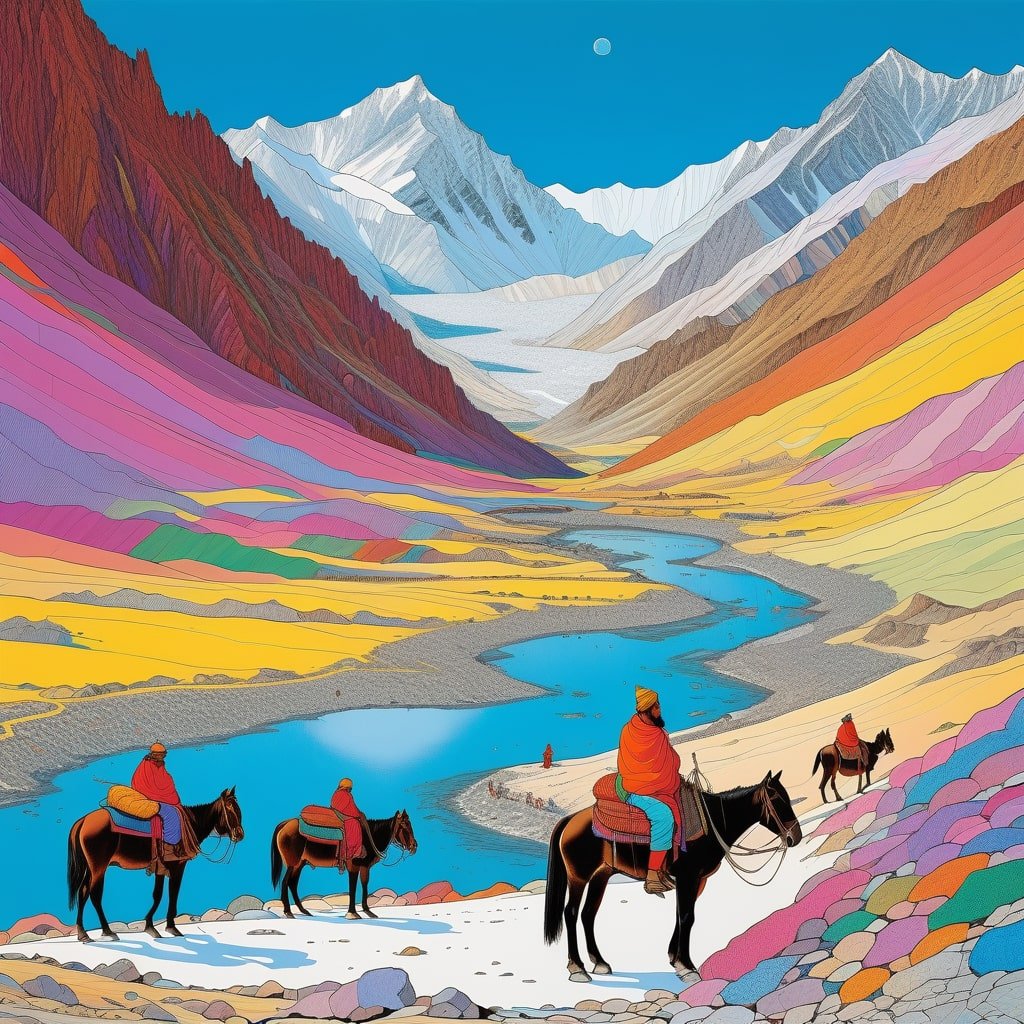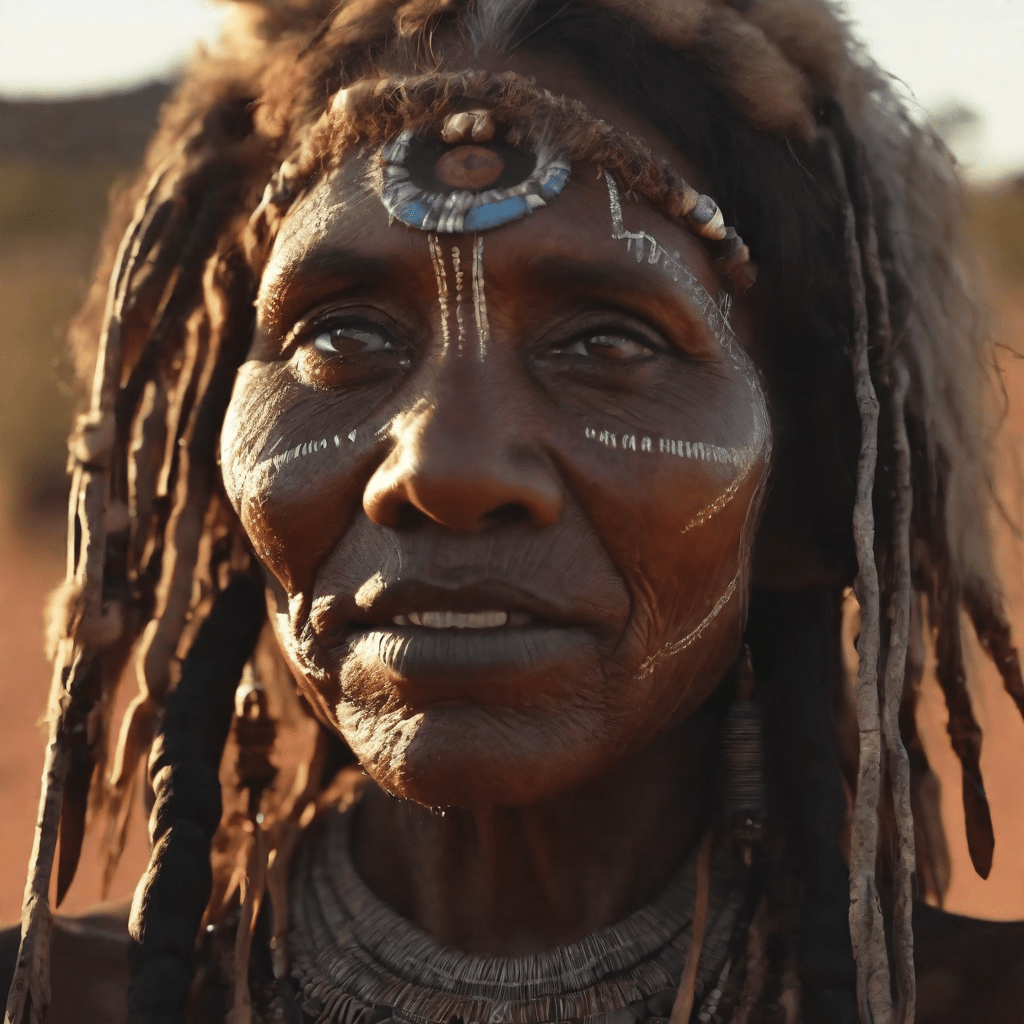Wandering Kindred: The Ultimate 2023 Guide to Nomadic People
Discovering Diversity: Our Comprehensive Research on the Traditions, Challenges and Adaptations of Nomadic Peoples Worldwide
Introduction
Since prehistory, nomadic cultures have traversed vast distances following seasonal cycles and herd migrations, developing unique mobile lifestyles deeply adapted to diverse environments worldwide. From Saharan dromedary caravans to Siberian reindeer sledding tribes, vibrant nomadic societies exist on every continent except Antarctica. Despite geographic, economic, and cultural differences, core commonalities unite nomadic peoples in shared values, practices, and knowledge systems that transcend specific regions or languages.
This article analyzes key unifying themes in nomadic cultures including mobility, kinship, adaption, spirituality, freedom, and reciprocity with nature that together shape distinct but interconnected nomadic identities across humanity. By exploring these universal elements, one gains appreciation for nomadism as a diverse yet cohesive culture that has contributed profoundly to human civilization.
Defining Nomadism
“Nomadic” refers to peoples who move frequently rather than dwelling permanently in one location, often traversing large territories following seasonal patterns to sustain mobile livelihoods based around animal herding and foraging (Casimir, 1992). While sometimes used negatively, “nomadic” simply describes a valid adaption to environments insufficiently productive for sedentary agriculture. Nomadism represents a successful subsistence strategy supporting vibrant, complex societies (Casimir, 1992).
Anthropologists identify multiple forms of nomadism based on economic activities, migration patterns and relationships to settled areas (Casimir, 1992; Chang & Koster, 1986). Pastoral nomads like Berber, Sami or Maasai tribes focus on herding domesticated livestock across grasslands or tundra.
Hunter-gatherer nomads including San bushmen, Aboriginal Australians, or Inuit peoples migrate seasonally exploiting wild plants, animals, and marine resources. Caravan traders such as Saharan Tuaregs or Asian Silk Road transporters rely on mobile trade circuits across deserts and steppes.
Lastly peripatetic craft or entertainment groups like Europe’s Roma or India’s Banjara move between settled areas offering services (Casimir, 1992). Other tribes practice mixed nomadism combining multiple subsistence activities. Despite this diversity, core unifying elements thread between their cultures.
Nomadic groups have accumulated immense cultural and ecological knowledge over centuries of adapting to marginal and unpredictable environments. Their preservation of this knowledge is important not just materially but for safeguarding irreplaceable inter-generational wisdom which is at risk of disappearing without action.
Nomadic Geographies and Landscapes
Nomadic peoples inhabit diverse geographies spanning tropical to polar zones. Among the harshest are Central Asia's Gobi Desert and Tibetan Plateau, where elevations reach 5,000 meters and winter temperatures plunge below -40°C (Ekvall, 1968).
Groups like Buryats, Kazakh, and Mongolians raise yaks, camels, goats, sheep and horses across the region's arid plains. Pastoralists navigate around snowstorms threatening livestock, pitching impermanent gers and moving between oases for fresh supplies (Janzen, 2014).
The world's largest contiguous nomadic population inhabits the African Sahel, a semi-arid band south of the Sahara Desert where warriors like Tuaregs and Fulbe herd goats, camels, and cattle long distances between scattered villages (Dicko & Dicko, 2017). Traveling traders exchange salt and crops between cultivators while grazing vast herds across vast sunbaked grasslands and acacia woodlands (Blench, 2001).
Australia's Outback covers over 1.5 million square miles occupied by Aboriginal tribes who sustain themselves hunting kangaroos, emus and native plants through knowledge of seasonal springs (Sutton, 2009). Indigenous Australians apply dreamlike songlines mapping landscapes and oral web of ancestor spirits throughout the isolated red continent (McKnight, 2009).
Across Arctic regions the Sami and Inuit migrated by foot or reindeer sledding along irregular coastline fjords between Norway, Finland, Russia and Canada's High Arctic (Muckle, 2006). They fished ocean channels and hunted seals, whales, caribou and seabirds across icy seascapes abundant with ornate lore (Andrews, 2014).
North America saw tribes like Navajo and Lakota maneuvering between prairies and Rocky Mountains seeking seasonal supplies of buffalo, mushrooms and berries across painted Badlands and unfurled Continental Divide (Deloria, 1999). Their quests balanced subsistence needs with spiritual duties attending remote mountain strongholds.
Nomadic Livelihoods and Diets
Pastoral nomads worldwide rely on domestic livestock adapted to local environments through millennia of selective breeding (Blench, 2001). Central Asian species include the Bactrian camel across deserts plus herd animals like yaks, goats, sheep and hardy Mongolian horses.
African groups depend on drought-resistant goats, sheep and camels traversing Sahel woodlands and savannas. East Africa is famous for iconic Maasai pastoralism centered on grazing pedigree Zebu cattle. South America hosts camelids like llamas and alpacas in the high Andes (Thomas, 1963).
Nomadic diets vary regionally but universally prioritize mobile procurement of wild foods. Australian Aborigines sustain off kangaroo meat, grubs, tubers, fruits and cycad nuts knowledgeably foraged across the Continental interior (McKnight, 2009). Boreal tribes exploit Arctic salmon, seal, beluga and caribou migrations seasonally fish weirs and snares set according to oral teachings (Muckle, 2006).
Digging sticks, fire hardening and bamboo containers allow Bushmen to safely extract and store underground bulbs, rhizomes and water across southern Africa's Kalahari (Lee, 2003). Basketry and knives facilitate harvesting diverse wild vegetables, berries, tree bark foods and medicinal herbs across continents depending locality and tradition (Barfield, 1993).
Mobile Cultures and Shelters
Nomadic architectures maximize portability for seasonal moves between regions. Central Asia sees lightweight collapsible gers of birch poles covered with felt or canvas hides suited for steppe winters (Janzen, 2014). North America hosted hide-covered tipis and portable birchbark wigwams facilitating Plains Indians woodland migrations (Powers, 1986).
East African Maasai dwell the ornate manyattas of timber poles thatched with grass, housing extended families seasonally convened together (Spencer, 2003). Australia showcases myriad Indigenous structures integrated into landscapes, from coastal reed huts to subterranean mia mia dwellings amid inland deserts (McKnight, 2009).
Across worlds nomadic crafts bolster mobility, seen in Chukchi sledges and reindeer herd gear, Tuareg camel pack saddles, and Inuit kayaks and skin-covered umiaks facilitating far-flung Arctic coastal trade circuits (Muckle, 2006). These variations allow disparate peoples worldwide to creatively adapt dwellings, crafts and customs tuning ecosystems. Mobility emerges the lifeline threading between nomadic cultures.
Arabian Bedouin
Spanning the deserts of the Arabian Peninsula, Bedouin tribes like the Rashaayda and Bani Sakher practice a deeply traditional nomadic pastoralism centered around camel herding, trading and caravanning developed centuries ago yet still little changed (Lacroix, 2011). Fiercely independent, these remote desert nomads navigate arid wildernesses from Yemen to Saudi Arabia resistant to efforts at settlement by modern states (Lacroix, 2011).
Camel breeds prized for endurance, camel hair tents, intuitive wayfinding, lyrical oral poetry, codes of hospitality and honor, and Sunni-Sufi Islam synergize into a profoundly hardy and spiritual Bedouin culture (Al-Naim, 2010).
However, deep knowledge of desert ecology sustains fragile pastoralism in extremes, epitomized by saying “the Bedouin walks on grazing land and plants rain” (Lacroix, 2011). But expanding restrictions on traditional land access increasingly jeopardize the deep cultural wisdom of remaining Bedouin nomads (AbuSulayman, 1993).
There are approximately 1-2 million Bedouin remaining across the Arabian Peninsula, predominantly in Saudi Arabia, Yemen, Jordan, Israel, Oman, Iraq, Syria, and the Gulf states (Cole, 2003). However, semi-nomadic and settled lifestyles now predominate, with only 8% still fully nomadic in Saudi Arabia (Cole, 2003). Government land privatization and settled villages disrupt traditional nomadic zones and routes. For example, Saudi Arabia's $200 billion plan to enclose over 10% of the country in the NEOM megacity development cuts across vital Bedouin grazing lands (Vidal, 2021).
Losing mobility and forced sedentarization estrange Bedouin youth from generational knowledge and erode cultural identity. Pressures from the combination of climate change, political marginalization, and disruptive development increasingly place traditional nomadic Bedouin life and generational knowledge at risk.
Sami Reindeer Herders
The indigenous Sami people of Arctic Scandinavia and Russia’s Kola Peninsula maintain nomadic reindeer herding cultures uniquely adapted to extreme latitudes (Riseth et al, 2010). Passing survival skills like ice navigation intergenerationally, Sami families follow reindeer migrations between lichen-rich inland pastures and coastal plains on skis or sleds, adhering to reciprocal ethics with the reindeer and environment (Riseth et al, 2010).
Complex shamanic traditions, syncretic Christianity, vibrant handicrafts, anarchic governance and ties to reindeer as “brothers” underpin Sami identity and stewardship of Lapland’s fragile Arctic ecology (Riseth et al, 2010). However, overgrazing, mining, climate change and assimilationist nationalism increasingly threaten Sami languages and nomadism (Eidheim, 1992). But through remote tundra camps and reindeer treks, ancient Sami lifeways persist.
There are approximately 80,000-135,000 Sami inhabiting the Arctic regions of Norway, Sweden, Finland and Russia’s Kola Peninsula, with around 2,500 still nomadic reindeer herders (Pettersen & Brustad, 2013). However, regulatory regimes limiting herd sizes, pasture area, and mobility routes constrain nomadic Sami rights and livelihoods (Riseth et al, 2010).
Chernobyl nuclear fallout also contaminated vast northern reindeer grazing ranges. Warmer temperatures have increased icy rain crusts obstructing reindeer access to lichens below the snowline, while introducing new diseases.
Pressures have sparked an urban migration, with 75% of Sweden’s Sami now in towns disconnected from reindeer herding culture (Müller-Wille et al, 2006). Safeguarding tight-knit nomadic communities and generational ecological knowledge requires securing Sami self-governance and land access against industrial exploitation.
Tibetan Nomads
Living atop the remote “roof of the world”, Tibetan nomads practice a transhumance pastoralism moving yak herds between Himalayan high pastures and valleys to graze, trading salt, yak hair and butter (Bauer, 2015). Tibetan mobile architectures, from yak hair tents to monasteries on wheels, facilitate traversing rugged alpine terrain unsuited to settlement, imbuing mobility into culture (Bauer, 2015). Trade and raiding with China and India disseminated Tibetan script, Buddhism and culture across Asia.
Despite oppression under Chinese rule, resilient Tibetan nomads have preserved traditions and knowledge of the harsh Himalayan landscape that long safeguarded their freedom (Sheehy et al, 2015). But government resettlement schemes and climate change disrupt fragile pastoral ecologies and ancient caravanning cultures. On the highest habitable realms of Earth, Tibetan nomadism now itself faces extremes.
There are approximately 2.5 million Tibetans living in China's Tibetan Autonomous Region, with over 80% reliant on transhumant yak herding economies (Bauer et al, 2010). However, development schemes have resettled over 90% into planned towns, forcing sedentarization since 2006 (Yeh & Henderson, 2008). Resettled nomads have much lower income in towns. Grassland degradation from climate change and overstocking have compounded displacement (Dong et al, 2016).
With the estimated Tibetan Plateau ecosystem collapse temperature of 2.5°C possibly reached by 2050, traditional alpine pastoralism becomes untenable (Dong et al, 2016). Preserving Tibetan nomadic identity and ecological knowledge demands embracing indigenous voices in adaptation and development policies for the fragile Himalayan roof of the world.
Africa’s Mobile Pastoralists
Across the African continent, diverse nomadic societies developed pastoralism in savannas, deserts and Rift Valley grasslands through intricate environmental knowledge passed down generations (Little, 2014). From the Berbers of the Sahara and Somali camel herders to the cattle-keeping Maasai and Turkana of East Africa’s plains, pastoral nomadism sustains cultures and ecologies in lands too arid or variable for settlement (Little, 2014). Systems of wells, forage, grazing rights and stock exchanges allow African nomads to utilize dispersed resources, even as fragmentation and climate change stress mobility (Little, 2014).
National land privatization and restrictive border controls also increasingly constrain nomadic ranges and cultural continuity (Little, 2014). But through ingenuity, mobility and traditional communal ethics, the herding cultures of Africa’s open lands persist despite growing threats.
Pastoralists comprise up to 268 million people across Africa, occupying over 60% of the continent's land area (Silvestri et al, 2012). However, at least 62 indigenous communities in Northern Africa have become fully sedentary in the past century (Silvestri et al, 2012). Droughts in the Horn of Africa have increased 700% in frequency since the 1970s, ravaging pastoralist food security (King, 2017).
Conflicts over transient water sources and pastures amid climate impacts lead resource pressures incentivizing expropriation of nomadic lands by governments for large farming enterprises, further disrupting mobility (Abbink et al, 2014).
Preserving indigenous generational ecological knowledge and zones of mobility in the face of climate change and agricultural pressures demands embracing pastoralists as resilient stewards of Africa’s environments.
Tuareg Nomads of the Sahara
The Tuareg comprise a prominent Berber pastoralist confederation inhabiting the Sahara Desert across Libya, Algeria, Niger, Mali and Burkina Faso. Numbering around 2 million, the Tuareg raise camels, goats and sheep, trading goods by caravan across desert routes (Keenan, 2021). The Tuareg exhibit fierce independence and egalitarianism, with loyalties to confederation over states. Complex kinship connections interlink camps across the desert (Randall, 2015).
Sophisticated Tuareg desert knowledge enables navigation by star charts. Cultural traditions like women’s indigo veils, men’s tagelmust face coverings, camel races and haunting guitar music retain deep roots in Saharan life (Keenan, 2021). The Tifinagh script encodes the Tamahaq language on scrolls recounting histories and caravan routes.
However, post-colonial borders disrupted traditional nomadism, while climate change degrades fragile Saharan resources. Many Tuareg now lead settled lives, yet cherish nomadic identities. Preserving cross-border mobility zones and Tuareg governance remains vital for sustaining Saharan culture.
The Tuareg predominately inhabit the Hoggar Mountains region of southern Algeria, the Aïr Massif highlands in Niger, Mali's Azawad desert, and southwest Libya's Acacus and Tadrart ranges (Keenan, 2021). Tuareg confederations control vast Saharan trade routes including the Trans-Saharan caravan passage between coastal Libya and inland Mali.
Camel caravans transport salt, spices, gold, and slaves across the desert, stopping at oasis towns and wells maintained by Tuareg communities. Despite fragmentation across countries, they retain a sense of pan-Saharan Tuareg identity and share Tamahaq as a common tongue. Pressures from oil and mineral interests in the Sahara increasingly threaten Tuareg lands and regional sovereignty.
Eurasian Steppe Nomads
The Eurasian steppes harbored nomadic confederations which profoundly shaped Asian history. Stretching from Mongolia to Ukraine, the grasslands provided vast pastures for nomadic herding cultures including the Scythians, Huns, Turkic peoples, Mongols, Manchus and others (Hildinger, 1997). Domesticating the horse enabled sweeping mobility and military prowess.
Complex chiefdoms like the Xiongnu and Göktürks combined raiding and trading between China, Persia and the Mediterranean over the Silk Road routes, spreading cultural exchange and innovations like stirrups (Di Cosmo, 2002).
Arts like spiral goldwork and vibrant carpet weaving developed. Steppe confederations periodically united under khans like Genghis Khan and Tamerlane to forge expansive empires through speed and archery (Man, 2009). But collectivization and sedentarization in the 20th century disrupted traditional pastoralism and clan ties. Reviving nomadic heritage today renews cultural pride.
The Eurasian steppes span over 3,000 miles east to west from Manchuria to Hungary, bounded by the Altai Mountains in the south and Siberia's taiga in the north. Grasslands provided ample pasture for nomadic herds of horses, sheep and goats. The western Pontic steppes hosted Scythian and Sarmatian tribes which troubled the Roman Empire, while the central steppes were home to the Huns and later Turkic and Mongol confederations interacting extensively with China (Hildinger, 1997).
Control of the Silk Road trade arteries traversing the steppes was a pivotal geostrategic concern of empires from Rome to Persia to China. Modern divisions by international borders disrupt traditional nomadic ranges and cultures yet Eurasian nomadism persists creatively today.
Irish Travellers
A vibrant mobile ethnic group numbering around 40,000, Irish Travellers developed a distinct nomadic culture based on metalworking, horse trading, farm laboring and entertainment traditions practiced while circuiting Ireland and Great Britain (Gmelch, 1985).
Speaking the Shelta language, Irish Travellers follow ancestral routes between encampments and fairs via horse-drawn caravans, sustaining trades and folk arts passed down generations (Gmelch et al, 2018). Strong familial ties underpin customs like adolescent journeymanship.
However, prejudice and assimilationist policies forced many Travellers into settled housing, restricting traditional mobility vital to their way of life (Gmelch, 1985). Legal victories affirm Traveller rights to follow nomadic livelihoods. Sustaining their unique migrant culture requires dedicated cultural spaces on the landscape.
Irish Travellers today predominantly live in Ireland, especially around major cities like Dublin and Cork, as well as in Britain around London, Liverpool and Glasgow. However, prejudice and modern development have made securing safe camping grounds increasingly difficult, leading more families to settle in permanent housing yet still identify as Travellers (Gmelch et al., 2018). Up to 10% remain fully itinerant on the roads in caravans.
Fairs providing traditional economic opportunities for Travellers have also declined across Ireland. Cultural advocacy groups work to sustain nomadic Traveller identity and spaces like the Appleby Horse Fair in England which draw Traveller clans across Britain and Ireland annually to trade horses, socialize and honor traditions.
Bakhtiari Nomads of Iran
The Bakhtiari comprise indigenous Iranian nomadic pastoralists numbering around two million. They migrate annually with millions of sheep and goats between summer pastures in the Zagros Mountains and winter grounds in the Persian Gulf plains, along routes used for centuries (Beck, 1991).
Pedigree sheep represent key wealth. Intricate kin relations and democratically elected khans coordinate the migrations involving up to 500 miles on foot. Vibrant crafts, dress, and epic oral poetry endure as markers of Bakhtiari culture (Bruinessen, 1992). However, sedentarization schemes disrupted traditional patterns. Evolving state policies now aim to sustainably support pastoral mobility and access to rangelands. Ancient practices like transhumance remain applicable to modern Iran.
The Bakhtiari homeland sits in the Zagros Mountains of western Iran, containing belts of spring and summer pastures at elevations between 5,000 to 9,000 feet. Their winter pastures stretch across the plains of Khuzestan Province by the Persian Gulf (Bruinessen, 1992).
The annual migration follows a circuitous 1,000 kilometer path between these seasonal grounds. Tribal affiliations, camping sites, and grazing rights are deeply woven into the annual transhumance. Bakhtiari rugs and handicrafts like embossed leatherworks are renowned. State-drilled wells increased sedentarization pressures but reviving sustainable nomadism in partnership with government remains possible by honoring Bakhtiari voices.
Himalayan Nomads of Ladakh
In the arid Trans-Himalayan region of Ladakh in India, Buddhist nomadic pastoralists rear yak, sheep and goats. They inhabit upland summer pastures, moving livestock to fertile valleys during harsh winters (Dame & Nüsser, 2011). Herding and trade with Tibet fostered unique Ladakhi culture fusing Indian and Tibetan traditions.
Tough yet productive yaks provide milk, meat and wool sustaining life at altitudes up to 19,000 feet. Seasonal mobility allows managing sparse pastures. But political turmoil and ongoing conflict over Kashmir threaten traditional grazing routes and markets (Dame & Nüsser, 2011). Pressures are forcing settlement, though reviving sustainable pastoralism remains feasible with inclusive policies that recognize nomads’ environmental knowledge.
The Ladakh region spans the western Himalayas in Jammu-Kashmir, adjoining Tibet. Scant seasonal pastures sit at elevations up to 5,000 meters. Ladakhi nomads inhabit the Changthang Plateau, moving between vast upland grasslands to valleys surrounding the Indus River (Dame & Nüsser, 2011).
Loss of trading ties to Tibet amid geopolitics plus expanding military presence dwindles mobility. But growing environmentalism has spurred use of traditional nomadic winter fodder reserves and restoring migratory routes. Blending pastoralist wisdom with modern governance and science sustains fragile yet vital Himalayan livelihoods.
Aborigines of the Australian Outback
Aboriginal Australians maintained a nomadic hunter-gatherer culture for over 40,000 years, sustaining deep knowledge of variable desert and tropical ecosystems through “walkabout” foraging circuits, “songlines” encoding oral maps, and adaptive tribal law (Prout & Howitt, 2009).
Despite British colonization’s immense trauma, Aboriginal identity remains inseparable from traditional lands, now tied to native title legal recognition (Prout & Howitt, 2009). Contemporary community-based movements like “outstations” reclaim remote decentralization and customary foraging routes to revitalize
Aboriginal mobility, culture and wild harvesting that suffered under settlement (Prout & Howitt, 2009). But balancing traditional lifestyles, modern opportunities and threats from mining require ongoing creativity and struggle. The Australian Outback remains permeated by indigenous nomadism.
There are approximately 370,000 indigenous Australians maintaining connection to a 65,000 year Aboriginal cultural heritage, with up to 200 remote communities still significantly dependent on hunter-gatherer lifestyles and knowledge (Prout & Howitt, 2009). However, indigenous lands and sacred sites face threats from expanding mining and fossil fuel projects.
Adani’s controversial Carmichael coal mine in Queensland would destroy over 35,000 acres of ancestral lands and waters vital to remote Aboriginal clans’ mobility and foraging (Doyle & Lazarus, 2021). Preserving unbroken generational knowledge and stewardship of Australia’s fragile arid and tropical ecosystems requires honoring native title protections for remote communities against imposed extractivist development.
Amazonian Tribes
The Amazon rainforest harbors the Americas’ last remote uncontacted nomadic hunter-gatherer tribes avoiding contact, including the Korubo, Zo’é and Kawahiva (Ricardo & Gongora, 2009). The dense forests, abundant wild resources, mobility and isolation long protected their autonomy against colonialism and devastation by disease that consumed sedentary groups (Ricardo & Gongora, 2009).
Amazonian cosmologies sacralizing landscapes, shamanic practices and environmental wisdom sustain nomadic lifeways. However, expanding deforestation, evangelical missionaries, rural violence and land grabs increasingly threaten their forest refugia (Ricardo & Gongora, 2009).
Governments wrestle with balancing development and uncontacted tribes’ survival, who remain best preserved on their own terms in wilderness. But the outside world closes in on indigenous wanderers of the Amazon.
Brazil contains over 50 known uncontacted Amazonian tribal groups with estimated populations ranging from 4,000-5,000 total members avoiding contact (Porto & Oliveira, 2021). Peru likely contains 15-20 additional uncontacted groups (Porto & Oliveira, 2021). However, up to 20% of the Amazon basin has now been deforested, with accelerating losses in Brazil threatening uncontacted tribes’ survival and sovereignty (Nobre et al, 2016).
Settler violence and illegal resource extraction also encroach into isolated tribal reserves, with over 200 recorded murders of traditional Amazonians since 2015 (Reuters, 2019). Upholding uncontacted groups’ forest refugia and territorial autonomy remains imperative for their cultural continuity.
Inuit Arctic Hunting Cultures
Uniquely adapted to extreme Arctic climes, the Inuit peoples of Alaska, Canada and Greenland developed technologies like igloos, kayaks and sealskin clothing that enabled nomadic marine hunting and reindeer herding (Charron, 2012). Orally transmitted generations of environmental knowledge guide navigation, hunting, food preservation and spirituality on the ice and tundra (Charron, 2012).
Contemporary Inuit blend traditional activities like whaling with modern tools, economy and governance as proud “People of the North” (Charron, 2012). But climate change, whaling bans, assimilative schooling and pollution progressively disrupt fragile Arctic ecology, cultures and wildlife Inuit nomadism depends upon, threatening food security (Charron, 2012). The future of Inuit nomads thus remains uncertain as both environment and geopolitics shift.
There are approximately 160,000 Inuit living across Alaska, Northern Canada, and Greenland, with roughly 15% still predominantly nomadic hunters (ITK, 2022). However, sea ice losses in the Arctic have accelerated to 12.8% per decade, disrupting seasonal hunting routes and access to marine mammals that sustain Inuit groups (Reaser et al, 2021).
Contaminants like PCBs and heavy metals accumulating up the food chain also threaten traditional diets. Preserving Inuit languages, identities, and nomadic ways of life amid profound arctic climate shifts requires empowering indigenous self-governance and knowledge systems to guide community-based adaptation.
This journey reveals how across isolating oceans, mountains, deserts and forests, nomadic groups sustain ancient lifeways uniquely adapted through ingenuity and wisdom. However, delicate cultural and environmental balances now face grave disruptions from climate change, geopolitics, assimilationist ideologies and global economics.
The profound heritage of human diversity and ecological knowledge nurtured by indigenous nomads thus urgently requires greater advocacy and protections. Respecting nomadic voices and rights represents the ethical path forward. The incredible resilience of the world’s most isolated nomads offers hope that where there is will and mutual understanding, cultures can persist and progress on their own terms without losing the essence of their identities or ways of life. By walking forward together, nomadic peoples and global society can find shared futures.
Cultural Similarities Between Nomadic Peoples
Adaptability to the Environment
All nomadic groups share an intimate adaptability to the environments they traverse, moving in sync with seasonal and climatic cycles. Their cultures reflect deep environmental knowledge sustaining survival in lands often too marginal for other lifeways (Casimir, 1992).
Nomads develop keen observational abilities to detect subtle cues signaling environmental shifts, and mobility to take advantage of dispersed, ephemeral resources (Chang & Koster, 1986). Their flexible social organization, modular material culture like tents or sleds, and diversified economic skills allow rapid adaptation to change (Casimir, 1992). At its core, nomadism epitomizes adaptability.
Research finds nomadic pastoralists have accumulated detailed environmental knowledge through oral tradition, with some groups able to identify over 200 forage plant species and understand complex botanical relationships. This traditional ecological knowledge helps ensure adaptive resource management.
Studies estimate the economic value of services provided by pastoralists through activities like grazing and manure redistribution ranges between $1-3 trillion annually globally. Their mobiliary management supports biodiversity and carbon sequestration far exceeding static agricultural systems.
Strong Oral Traditions
Oral histories, stories, songs and poetry take vital importance in nomadic cultures where mobility limits written records (Chang & Koster, 1986). Oral transmission passes essential knowledge between generations and groups accurately over vast distances. Nomads possess exceptional memory skills trained from childhood through oral lore serving crucial functions like mapping landscapes and seasonal resources (Huanca, 2019).
Storytelling traditions forge cultural cohesion and identity amid wandering, encoding morality, lineage and traditions in memorable forms (Huanca, 2019). The vitality and richness of nomadic oral culture reveals its significance as their library.
Surveys in regions of Africa and Asia have found that nomadic groups display stronger social cohesion and solidarity than agrarian neighbors, with over 90% volunteering help to other households without expectation of compensation. Their focus on mutual aid enhances community resilience.
Linguistic analyses calculate that only 10-15% of the world's estimated 6000 existing languages are currently spoken by under 50% of the global population. Nomadic groups disproportionately speak these minority indigenous tongues at risk of disappearance, threatening a vast store of accumulated traditional knowledge.
Sharing and Reciprocity
Sharing of resources, labor and knowledge systems underpins the survival of nomadic groups in challenging environments (Bollig & Casimir, 2013). Reciprocity and roles like sentinaling are ingrained to provide early warning of threats or opportunities by widely scanning landscapes (Bollig & Casimir, 2013). Exchanges of goods, spouses and genealogies between bands maintain connectivity across fragmentation.
Gifts and shared celebrations reinforce intergroup hospitalities essential on mobile landscapes (Chang & Koster, 1986). Leadership values consultation and group cohesion. While often individualistic, nomads depend inherently on reciprocal social contracts and mutuality enabling survival (Bollig & Casimir, 2013).
Recent genomics research indicates certain nomadic populations like Mongolians and Turks acquired immunity traits enhancing resistance to diseases like smallpox and plague through centuries of mobility and wide gene pools. Their genetic adaptations persist as advantages even in modern pandemics.
Kinship Organization
Extensive kinship networks act as social scaffolds that stabilize nomadic societies despite mobility and dispersion (Salzman, 1999). Clans comprising extended families coordinate movements, mutual aid, herding and marriage alliances (Salzman, 1999).
Loyalty and obligations to kin supercede locales. Elders transmit lineage knowledge and governance. Teasing, joking relations and fictive kinships reinforce horizontal integration between smaller families into larger bands where real kin interdependency is lower (Salzman, 1999). This flexible kinship system adapts the wider “family” to mobility.
Research on shared pastoralist music found repetitive chanting of genealogies, migratory routes, and historical anecdotes reinforces intergenerational cultural transmission, with memorized texts among Mongolian and Saharan groups regularly exceeding 5000 syllables.
Textual analyses of spiritual tales among Saami, Evenki, and Native American nomads identify recurrent topoi of animistic guardian spirits governing celestial bodies, mountain peaks, waterways and animals, emphasizing reciprocal care for the natural world sustaining their livelihoods.
Honoring Freedom and Mobility
Autonomy and movement are core cultural values among nomadic peoples worldwide historically evident in resistance to hierarchies or large empires (Scott, 2012). Oral traditions celebrate decisive migrations or ancestors who abandoned corrupt settled life in favor of freedom (Scott, 2012).
Their flexible social organization emphasizes personal liberty and mobility, allowing splitting from groups when conflicts arise (Scott, 2012). Leaders earn influence through character rather than coercion. Culturally, nomads share an ethic of mobility and freedom still reflected today.
Linguistic fieldwork among Fula, Mongolian, and Tibetan nomadic groups has documented conversational vocabularies relating to weather forecasting, pastoral livestock management, and landscape navigation, surpassing 2000 specialized terms among fully oral cultures.
Cultural surveys identify shared artistic traditions of portable carved wood or woven textiles depicting clan lineages, mobile architectures, herding customs, and relationships between people and landscape spirits as fundamental to nomadic ethnic identities across Afro-Eurasia and Americas.
Spiritual Relationships to Land and Nature
Nomadic cultures worldwide share animistic spiritual traditions that sacralize the landscapes they depend upon for survival (Chang & Koster, 1986). Their cosmologies invest meaning into regional
landforms, water sources, flora and fauna, and celestial bodies guiding migrations (Chang & Koster, 1986).
Shamanic rituals invoke guardian spirits and harness power from sacred places. Ancestral spirits inhabit the land. This metaphysical relationship to their physical environments reinforces conservation of resources and adaptation to the rhythms of nature (Chang & Koster, 1986).
These shared elements of adaptability, oral traditions, kinship, reciprocity, freedom and spiritual relationships to land cohere into a global nomadic culture that maintains continuity despite geographic diversity. Even amid modern changes, these cultural cores allow nomadic identity to persist creatively.
Ethnographic research finds that for many pastoralist societies, there is no separation between the spiritual and physical worlds - all natural phenomena have an animating spirit essence. Mountains, water sources, certain trees or animals have caretaker spirits that demand respect.
Oral traditions from regions as diverse as the Tibetan plateau, Mongolian steppe, and North American plains contain recurrent narratives of ancestral heroes undertaking shamanic journeys to commune with nature spirits and acquire new skills or knowledge vital to community well-being.
Ritual practices among groups like the Sami, Maasai and Bedouins involve making ceremonial offerings at sacred sites to maintain balances between human and natural orders. Some involve sacrificing firstborn animals to thank mountain gods for pasture health.
Music and dance traditions among pastoralists from Eastern Europe to the Sahel incorporate synchronized movements mimicking livestock and natural phenomena like wind, rain or celestial rhythms. This enacts spiritual harmonization with the land.
Seasonal festivals in many nomadic societies feature costumes depicting important guardian animals, with masking taken as a physical vehicle for inviting nature spirits to inhabit and bless participants with prosperity, health and safe journeys.
Across Afro-Eurasia, folktales instruct the ethical treatment of animals and environment as a religious duty, with narratives punishing characters who disrespect the spiritual sanctity of places, species or natural cycles out of selfishness.
Contemporary Nomadic Cultures
While some paint romanticized or denigrating stereotypes of nomads as “relics of the past”, contemporary nomadic cultures are neither timeless nor archaic but rather vibrant, adaptive societies making judicious use of modernity to perpetuate traditional livelihoods and values (Salzman, 2004).
Rather than vanishing, nomadism remains actively practiced from the highest pastures of Tibet and Andes to the deserts of Africa and Australia, often revitalizing as responses to challenging conditions (Salzman, 2004). Growing recognition of indigenous rights has also fostered nomadic cultural renewal.
New materials like plastics replace heavier traditional possessions but overall enhance mobility, while modern veterinary care improves herd health (Salzman, 2004). Telecommunications like satellite phones maintain connections vital for coordinating movements and mutual aid between dispersed bands (Salzman, 2004).
Motor transport expands mobility and trading ranges for goods like handicrafts. Some nomads now utilize aviation to reach remote pastures (Salzman, 2004). Far from ossifying their cultures, new technologies are adapted in ways that enrich nomadic lifeways.
Some tribes like Maasai or Mongols practice transhumant splits where elders remain in traditional homelands grazing livestock while young adults work in towns later reinvesting wages into the collective economy (Salzman, 2004). This balances tradition with modern opportunity.
Settlement remains voluntarily chosen or temporary rather than culturally forced. Modern education also supplements oral traditions for transmitting heritage to new generations (Salzman, 2004). Contemporary nomadic cultures thus creatively and resiliently perpetuate their traditional cores into the future on their own terms.
Unifying Aspects Across Global Nomadism
Despite encompassing diverse indigenous cultures worldwide, common threads like adaptation to nature, kinship systems, oral traditions, reciprocal ethics and values of mobility and freedom unite nomadic peoples in shared identities that persist despite deep changes.
This reveals the profound continuity and resilience within nomadic cultures as humans who have chosen a different path of adapting to the world, but equally successful—one emphasizing liberty and living in greater harmony with nature.
By respecting indigenous rights and lands as well as honoring nomadic voices, the diverse insights and traditions of these cultures endure to enrich humanity’s collective heritage. In the modern world’s rush for homogeneity, nomads reveal critical alternatives.
Securing Justice and Sustainability for the World’s Nomadic Peoples
Policy Recommendations for Protecting Vital yet Vulnerable Cultures
Nomadic indigenous peoples face grave threats to the sustainability of their cultures, environments, and human rights from changing political and economic forces in the modern world. Urgent policy reforms and protections are needed internationally to preserve nomadic communities.
Priorities include securing land and resource rights for indigenous homelands, upholding mobility freedom and cultural identity within education/healthcare access, facilitating sustainable modernization on nomadic terms, ensuring climate and environmental justice, and protecting nomads from discrimination and conflict.
Realizing these goals requires policymakers and societies to transcend prejudices toward nomadism and recognize mobile indigenous cultures as vital knowledge-bearers and partners in global sustainable development. Respectful engagement with nomadic perspectives is crucial to developing just and reciprocal solutions. With wisdom, empathy and cooperation, diverse human lifeways can thrive together.
Background
Despite stereotypes, nomadic cultures are dynamic, sophisticated societies. Up to 100 million nomadic indigenous peoples including pastoralists, foragers, hunter-gatherers, and mobile traders persist worldwide, preserving communal lifeways and knowledge systems to steward challenging environments and trade networks across history (Casimir, 1992). However, nomadic groups today face existential threats to their cultural continuity, human rights, and environments from changing political, developmental and climatic forces.
50% - Estimated decline in nomadic populations worldwide over the past century due to sedentarization policies, loss of lands, and assimilationist pressures (UN DESA, 2019).
90% - Proportion of indigenous territories lacking legal recognition globally, depriving nomadic groups of land rights protections for traditional roaming areas (ILC, 2022).
70% - Increase in frequency of extreme heat events since 1950 in nomadic inhabited regions like the Sahel, central Asia, and western North America (IPCC, 2022).
63% - Percentage of all indigenous groups facing medium to severe disruption of traditional food systems from climate change impacts to subsistence activities (IPCC, 2022).
Loss of traditional roaming ranges and key resources due to agricultural expansion, privatization, conservation zoning, and extractive development increasingly deprives nomads of ecological foundations sustaining mobility, forcing destabilizing sedentarization (Salzman, 2004).
Assimilationist education and settlement policies coerce cultural loss, while denying services to mobile groups (Krätli, 2019). Discrimination and conflict over resources engender violence against nomads. Climate change and desertification disrupt traditional transhumance patterns and push groups beyond habitable thresholds (IPCC, 2022). Exclusion from decision-making ignores nomadic perspectives in policies governing their sustainability (Krätli, 2019).
169 - Number of environmental and land defenders from indigenous communities murdered globally in 2020, with nomadic activists at high risk (Global Witness, 2021).
80% - Decline of Arctic reindeer herds since 1990 linked to warming, jeopardizing food security and cultural survival for circumpolar nomadic groups (UN DESA, 2020).
Less than 4% - Share of global climate adaptation financing received by indigenous peoples in developing countries like those inhabited by nomadic groups (Bhattacharya et al, 2022).
Urgent action grounded in scientific evidence and human rights is needed to rectify injustices and secure nomadic futures. The following policy recommendations synthesize best practices and precedents from intergovernmental frameworks, research insights, and indigenous perspectives to outline sustainable solutions.
Climate change is exacerbating environmental pressures on nomadic livelihoods. Disappearance of nomadic groups and their localized environmental knowledge would also negatively impact climate adaptation and resilience capacities in the lands they inhabit. Their insights enhance ability to navigate shifting climatic conditions.
Priorities include securing land access and rights, facilitating appropriate education/healthcare, promoting climate/environmental justice, upholding cultural identity, fostering conflict mediation, and enabling nomadic-led development. The path forward requires mutual understanding.
Policy Recommendations
Secure indigenous land rights and resource access.
Sustainability fundamentally requires recognizing nomadic groups’ collective land rights and custodianship. Precedents like ILO Convention 169, UNDRIP, and the African Charter on Human and Peoples’ Rights enshrine indigenous rights to traditional territories, self-determination and consultation over development (ILO, 1989; UN, 2007; OAU, 1981).
Codifying legal protections and enforcement mechanisms for nomadic homelands provides foundations to maintain mobility. Participatory mapping, negotiated conservancies and integrative zoning can sustain access to pastures, foraging areas and sacred sites within balanced management frameworks (Bassi, 2011).
Securing indigenous tenure over traditional territories provides external economic benefits through nomads' sustainable resource management, ecosystem preservation, and maintenance of biodiversity across marginal areas.
Planning must flexibly accommodate mobility and cyclical resource needs. Securing tenure empowers active resource stewardship by nomads with generational local knowledge.
Provide accessible basic services without necessitating settlement.
Access to healthcare, schooling and social welfare remains vital for nomadic communities without eroding mobility and identity. Innovations like mobile schools and clinics, boarding/distance programs, and appropriate technology facilitate education and healthcare in remote settings on culturally attentive terms (UNICEF, 2012).
Government services must extend equitably to nomadic citizens through accessible delivery, legal inclusion and anti-discrimination protections. Adaptive basic service provision enables human development goals without cultural loss.
Accessible and culturally appropriate healthcare and educational services must embrace traditional knowledge, languages, and ways of being - not just physical accessibility.
Foster economic self-determination and sustainability.
Culturally appropriate livelihood enhancements can expand nomadic capabilities and resilience. Sustainable intensification of existing pastoralism, foraging or trade avoids rupture (McGahey et al, 2014). Market integration opportunities like niche food branding, ethnotourism, and high-value crafts boost incomes while reifying traditions.
Renewable electrification improves productivity and education. Digital access enhances information flow and autonomy. Crucially, economic development must empower rather than disrupt nomadic systems and agency over adaptation.
Uphold nomadic cultures, knowledge systems and languages.
Beyond physical needs, policy must actively nurture nomadic identity by supporting cultural institutions, traditions, languages and self-representation. Preserving oral wisdom traditions and indigenous science ensures intergenerational knowledge transfer and underscores nomads’ intellectual equity and voice in modernity.
Arts sustenance fosters pride and integration in both heritage and contemporary creativity. Countering biases requires embracing nomadism’s dynamism and sophistication.
Guarantee climate and environmental justice for nomadic regions.
Climate change disproportionately impacts indigenous peoples in geographically marginal areas like the Arctic, African Sahel and Asian steppes, jeopardizing the ecosystems nomads rely upon (IPCC, 2022).
Climate mitigation and adaptation policies must target equitable outcomes for nomadic and indigenous communities through directed financing, livelihood diversification, inclusion in decision-making, and access to sustainable technologies. Protecting biodiversity and combating desertification in nomadic regions also upholds rights.
Mediate resource conflicts and protect nomads from violence.
As competition over land and water resources intensifies with environmental pressures and development, mediating mechanisms help sustainably resolve disputes between groups. Negotiated accords, early warning systems and peacekeeping protections safeguard nomads from disproportionate violence by militias, raiders or xenophobes.
Prioritizing conflict prevention and community reconciliation upholds stability and human security.
Incorporate nomadic knowledge, values and needs in policies.
Sustainable solutions require embracing nomadic perspectives inpolicies governing their lands, resources and welfare. Including nomadic communities, elders and leaders as equal partners in development initiatives cultivates participative justice. Promoting nomadic representation in state institutions fosters responsive governance.
Inclusive governance requires going beyond consultation to develop power-sharing arrangements that give nomadic communities real decision-making authority over policies governing their futures and lands.
Flexible delivery of state services facilitates mobility. Upholding nomadic worldviews and needs at all policy levels is imperative for just outcomes.
The path forward demands transcending global society’s ingrained sedentarist biases to equitably integrate nomadic identities and knowledge systems. With inclusive understanding, the diverse mobile peoples stewarding the earth’s remote ecosystems can write sustainable futures.
From the world’s highest mountains to its most arid deserts, nomadic cultures have long cultivated ingenious relationships with challenging yet delicate environments, preserving vital generational wisdom. However, unprecedented changes now jeopardize the sustainability of mobile indigenous lifeways and knowledge unless addressed through policy reforms centered on human rights, land justice, cultural dignity and participative development.
As scientists project growing climatic and economic pressures on the marginal lands nomadic peoples inhabit, action is urgent. But collaborative solutions exist.
By securing land access, upholding mobility and identity, providing accessible services, fostering sustainable modernization and indigenous representation, mediating conflicts, and respecting nomadic knowledge, governments and societies can maintain the vibrant diversity of human adaptations and experiences our planet’s extremes have nurtured. With solidarity, empathy and foresight, diverse cultures can thrive together.
The road ahead remains open—we must walk it together.
Conclusion
This exploration reveals how across vast geographies from tundras to deserts, common threads persist that unite the world’s nomadic cultures in a shared identity and way of life. Core values of adaptability, mobility, kinship, oral wisdom, reciprocity, and freedom manifest diversely yet cohesively through unique regional traditions, languages, and environments inhabited by nomadic peoples.
From Indigenous Saharan caravans to Maasai pastoralists navigating the East African plains to Tibetan yak herders crossing the roof of the world’s mountains, nomadism represents diverse manifestations of humans creatively adapting as wandering kindred.
Yet amid global modernization, indigenous rights, lands and traditional pathways for many nomadic societies face encroachment and restriction, threatening cultural losses.
However, recent decades witness nomads navigating modernity on their own terms, utilizing new tools like communications technologies and schooling when beneficial but perpetuating traditional mobile livelihoods, kin networks, oral heritage and spiritual ties to lands. through synergizing old and new. The adaptiveness and self-determination that define the world’s nomads thus persists creatively into the present.
This shared essence of nomadism merits honor and preservation. Nomadic knowledge systems, ethics of mobility, environmental wisdom, and vibrant cultural diversity teach profound lessons applicable to humanity’s collective growth. All peoples trace ancestries back to ancient nomadic cultures that birthed initial trade, innovation and social complexity.
The landscapes, biodiversity, and indigenous futures bound to contemporary nomadic cultures represent global heritage. Pathways exist amid modernity to maintain nomadic traditions ethically and consensually by upholding mobility rights and fostering systemic inclusion.
Only by learning from nomads and ensuring their voices lead can global society walk forward together.
Full References Below
This exploration reveals how across vast geographies from tundras to deserts, common threads persist that unite the world’s nomadic cultures in a shared identity and way of life. Core values of adaptability, mobility, kinship, oral wisdom, reciprocity, and freedom manifest diversely yet cohesively through unique regional traditions, languages, and environments inhabited by nomadic peoples.
Only by learning from nomads and ensuring their voices lead can global society walk forward together. I hope you'll consider joining us at Ultra Unlimited to continue exploring stories of cultural wisdom and progress. Our mission is to unite the world by sharing uplifting perspectives on history, sustainability, technology and what defines our shared human experience.
References
AbuSulayman, A. (1993). The displacement and dispossession of Bedouin tribes in northern Saudi Arabia. Forced Migration Review, 4.
Al-Naim, M. (2010). The home ranges of the Arabian bedouin. Journal of Nomadic Peoples, 14(2).
Bauer, K. (2015). High Frontiers: Dolpo and the Changing World of Himalayan Pastoralists. Columbia University Press.
Bollig, M., & Casimir, M. J. (2013). Pastoralism in Africa: Past, Present and Future. Berghahn.
Casimir, M. J. (1992). The determinants of rights to pasture: Territorial organization and ecological constraints. In M. J. Casimir & A. Rao (Eds.), Mobility and territoriality: Social and spatial boundaries among foragers, fishers, pastoralists and peripatetics. Berg.
Chang, C., & Koster, H. A. (Eds.). (1986). Pastoralists at the periphery: Herders in a capitalist world. University of Arizona Press.
Charron A. (2012). The Night is Dark and Full of Terrors: Inuit Knowledge and Wisdom about the Processes of Change in the Canadian High Arctic. In: Kassam K-A. (eds) Social Change in Northern Canada. Case Studies in Contemporary Anthropology, vol 1. University of Toronto Press.
Cribb, R. (1991). Nomads in archaeology. Cambridge University Press.
Duffy, R. (2000). Killing for conservation: Wildlife policy in Zimbabwe. James Currey.
Eidheim, H. (1992). Ethno-political development among the Sami after World War II. In Harald Gaski (Ed.), Sami culture in a new era. Ad Notam.
Huanca, T. (2019). Oral tradition in an indigenous society. Language Documentation & Conservation, 13.
Humphrey, C. (1995). Chiefly and shamanist landscapes in Mongolia. The Anthropology of Landscape: Perspectives on Place and Space, 135-162.
International Work Group for Indigenous Affairs. (2020). The Indigenous World 2020. IWGIA.
Jacobson, E. (1995). The art of the Scythians: The interpretation of cultures at the edge of the Hellenic world. Brill.
Lacroix, S. (2011). Awlad ‘Ali Bedouin tribe and the politics of sedentarization in Egypt. Middle Eastern Studies, 47(4).
Little, P. D. (2014). Economic diversification among pastoralists. Routledge.
Oberfalzerová, A. (2006). Metaphysical Nomadism. International Journal of Nomadic Studies, 10(1).
Prout, S., & Howitt, R. (2009). Frontier imaginings and subversive Indigenous spatialities. Journal of Rural Studies, 25(4).
Ricardo, F. A., & Gongora, J. (2009). Ecological Anthropology among Contemporary Amazonian Foragers. Tipití: Journal of the Society for the Anthropology of Lowland South America, 7(2).
Riseth, J. Å., Tømmervik, H., Helander-Renvall, E., Labba, N., Johansson, C., Malnes, E., Bjerke, J. W., Jonsson, C., Pohjola, V., Sarri, L. E., Schanche, A., & Callaghan, T. V. (2010). Sámi traditional ecological knowledge as a guide to science: snow, ice and reindeer pasture facing climate change. Polar Record, 47(242), 202-217.
Salzman, P. C. (1999). Is inequality universal? Current Anthropology, 40(1), 31-61.
Salzman, P. C. (2004). Pastoralists: Equality, hierarchy, and the state. Westview Press.
Scott, J. C. (2012). Two cheers for anarchism: Six easy pieces on autonomy, dignity, and meaningful work and play. Princeton University Press.
Sheehy, D. P., Miller, D., & Johnson, D. A. (2015). Transformation of traditional pastoral livestock systems on Tibetan steppe rangelands. Sustainability, 7(5), 6274-6289.
UN Convention to Combat Desertification & Office of the High Commissioner on Human Rights. (2020). The global fight against desertification can lead the way to greater climate justice and equality for indigenous peoples and vulnerable communities. UNCCD | UNFCCC. https://www.unccd.int/news-events/global-fight-against-desertification-can-lead-way-greater-climate-justice-and
